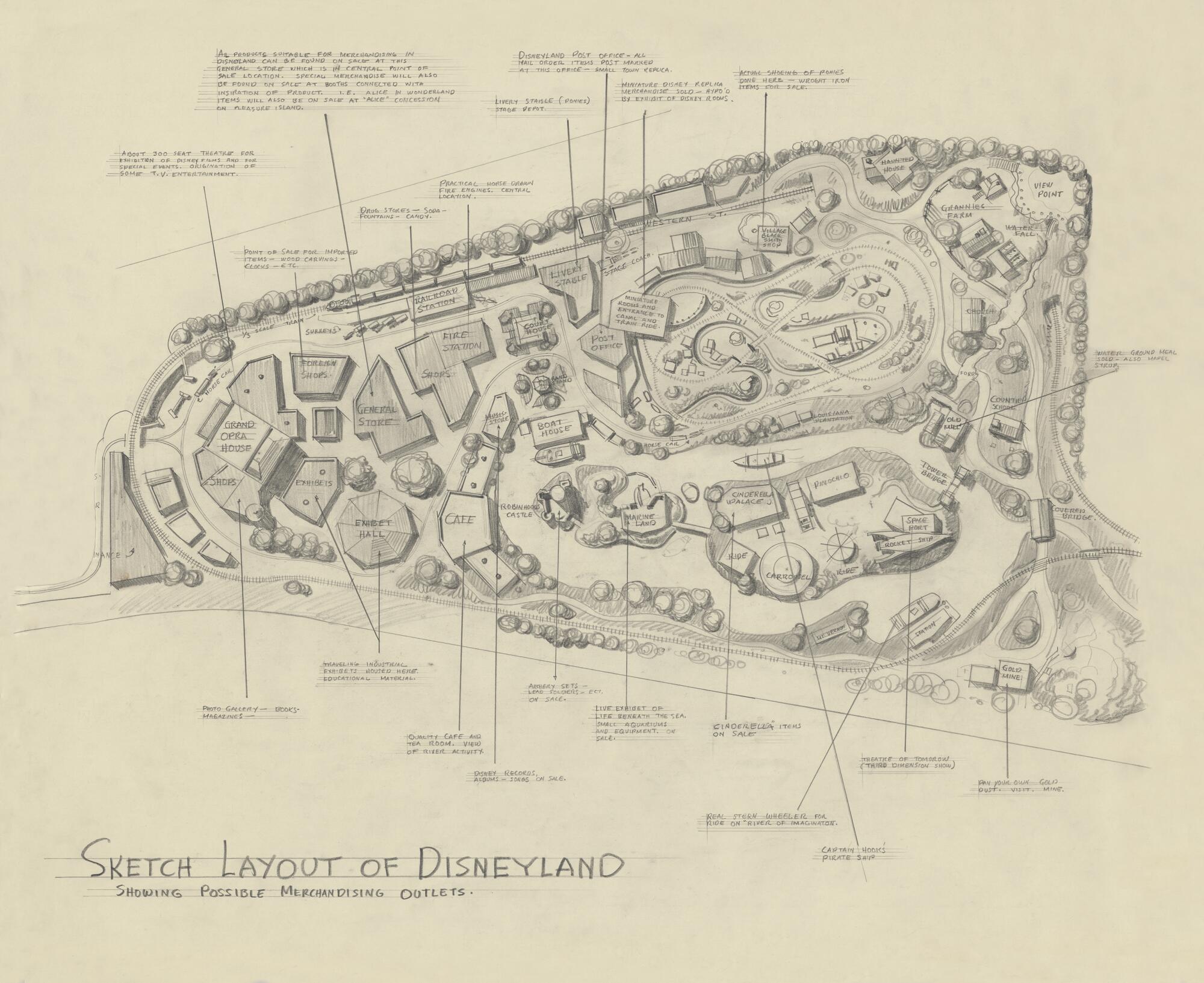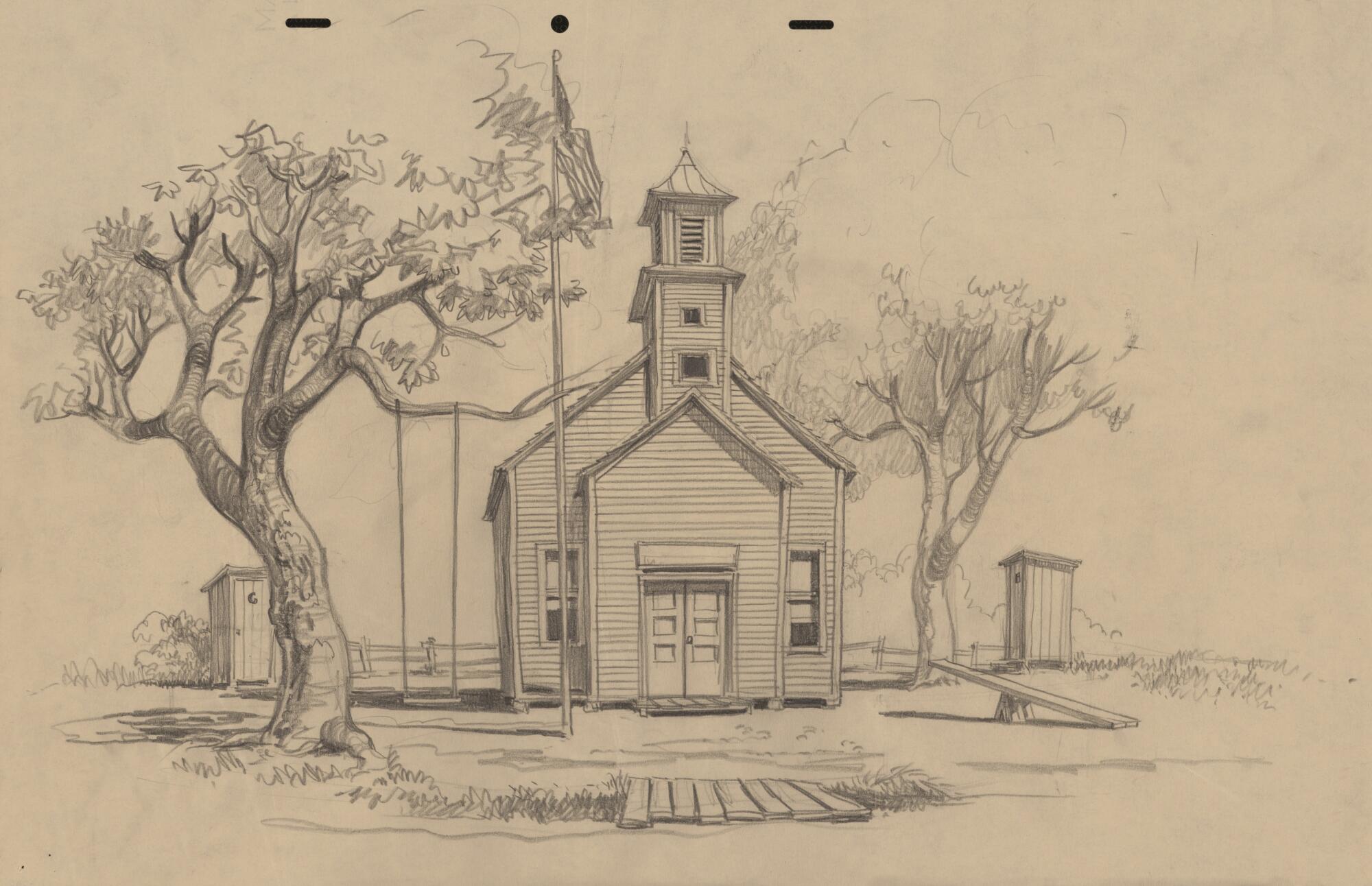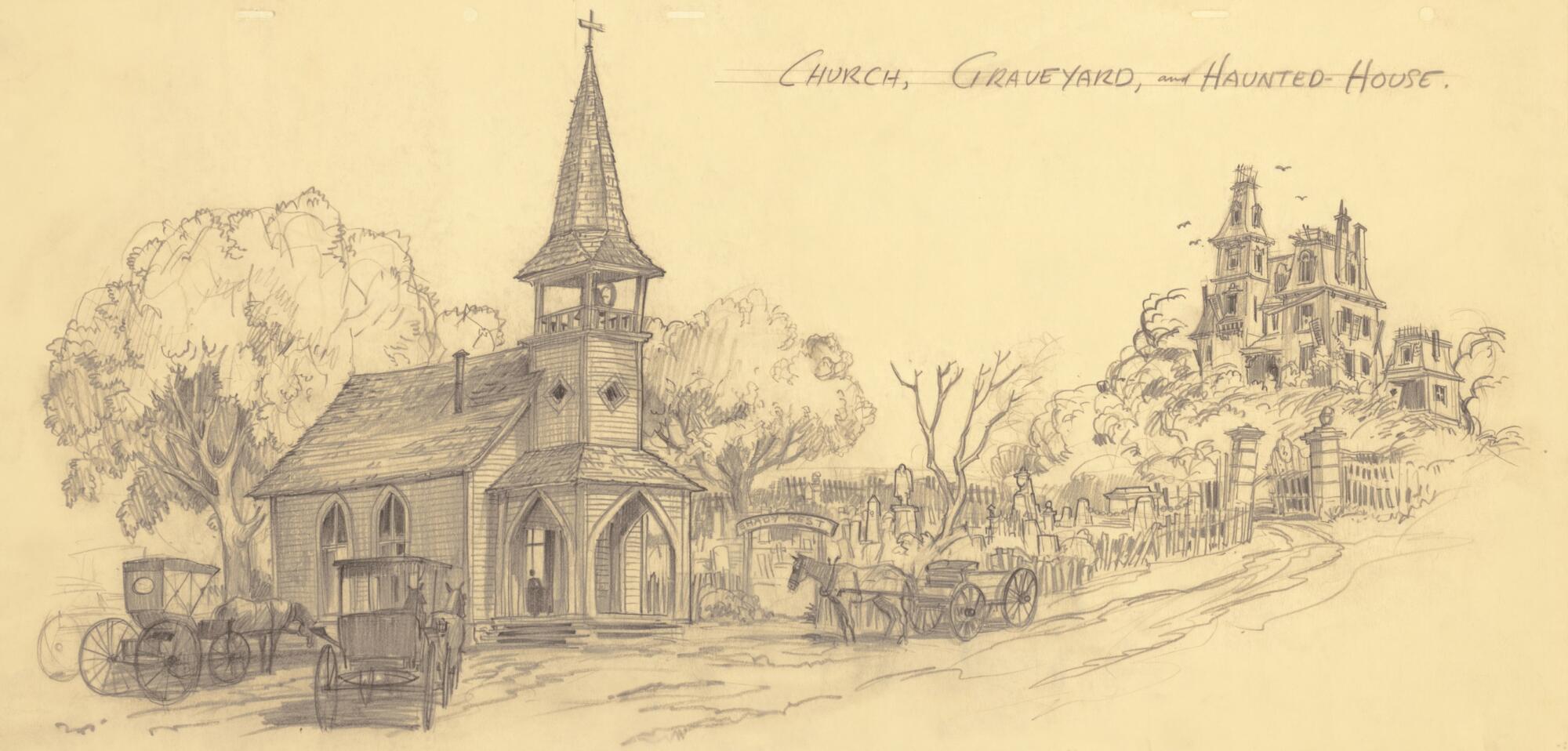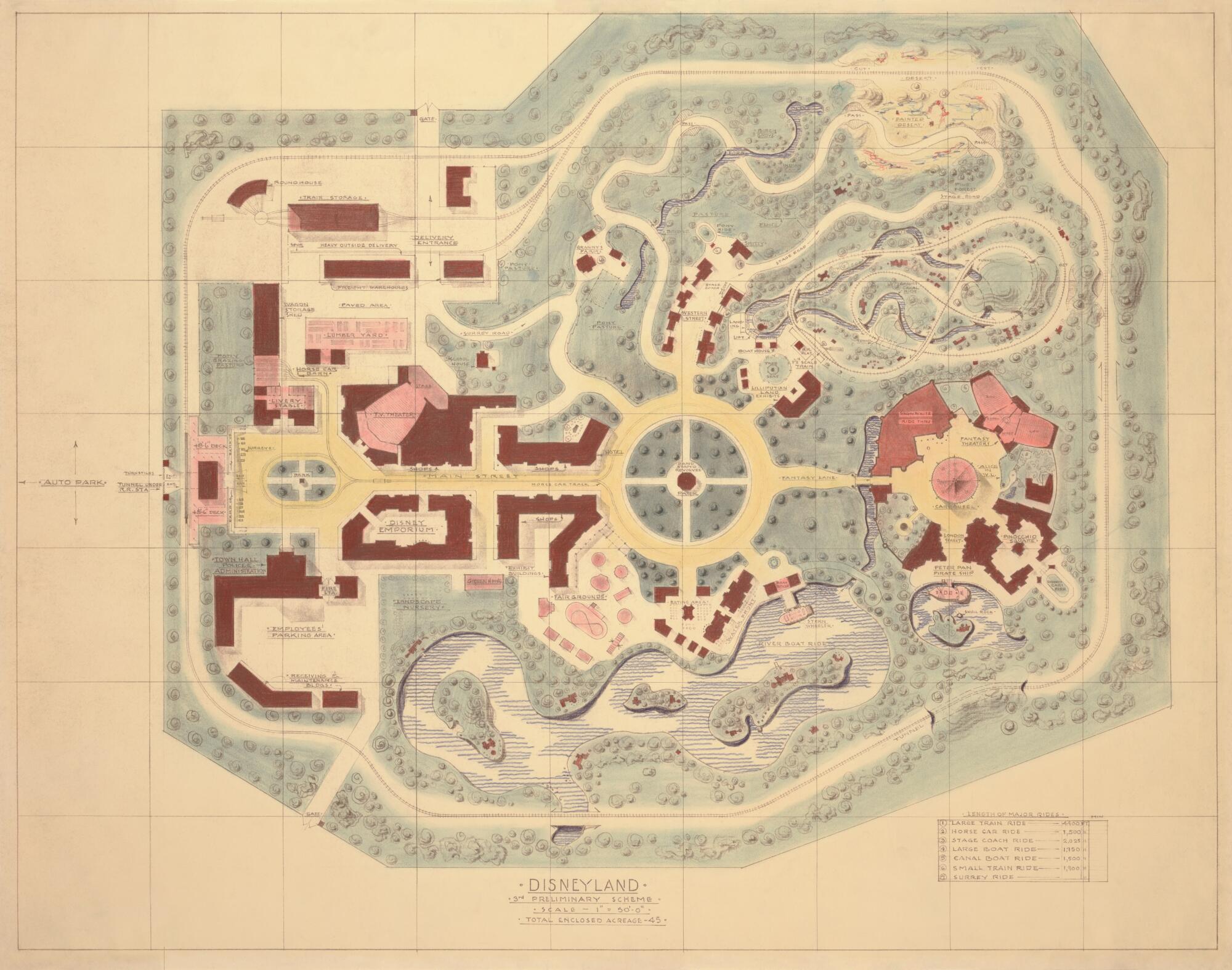There’s an oft-repeated Disneyland creation fable: Artist and animation artwork director Herb Ryman was given 48 hours to attract an early, closely detailed and romanticized map of the theme park, which might be used to assist promote the mission to buyers. Though that’s all true, Ryman’s work — one of the vital well-known and vital Disneyland drawings — was removed from the primary map of Disneyland, as it’s usually colloquially referred to.
Ryman’s work was the truth is an iteration of types, primarily based upon years of grasp planning from Walt Disney and early collaborator Marvin Davis, a cinematic artwork director accountable for a lot of Disneyland’s early designs. Some never-before-seen work of Davis and different Disneyland designers can be unearthed within the new e-book “The Happiest Place On Earth,” from animation producer Don Hahn and theme park designer Christopher Merritt. Each Hahn and Merritt have through the years morphed into theme-park historians, and the e-book is being launched July 15 to coincide with Disneyland’s seventieth anniversary.
“Marvin Davis claimed that, as he sat there, probably in a room by himself at the studio with Walt standing over him poking him in the shoulder, he did 133 revisions of these maps to get to the Disneyland layout by 1955,” Merritt says. “A few of these maps have been shown before but a lot of these have not been seen before.”
The archives at Walt Disney Imagineering, the secretive division of the corporate accountable for theme-park experiences. Discovered within the archives have been a number of maps from Marvin Davis that discover Disneyland’s roots.
(Walt Disney Co.)
The e-book will hint the event of Disneyland, beginning within the early ’50s when Disney flirted with the thought of putting the park subsequent to the studio in Burbank — ideas drawn by Harper Goff — to lots of Davis’ gradual developments of the theme-park type. Research them, and so they reveal what number of of Disneyland’s core concepts have been in place by the early Nineteen Fifties, though they morphed. Alice in Wonderland, for example, was as soon as envisioned as a walk-through attraction, to be positioned throughout the way in which from an archery in Fantasyland.
Hahn makes the case that lots of the early seeds for Disneyland have been planted throughout a 1948 journey that Disney and animator Ward Kimball took to Chicago. There, the 2 attended the Chicago Railroad Truthful, which had, amongst its sights, Abraham Lincoln reenactments and a re-creation of a frontier city.
“His first memo he did when he got home from the Chicago Railroad Fair was all about trying to create these certain regions,” Hahn says. “If you look at the early Burbank parks, there was a western village, there was a stagecoach, there was a railroad station, there was a Tom Sawyer-ish island. A lot of those things came from the Railroad Fair.”
And there was lots of early experimentation and plenty of a discarded thought. One in all Merritt’s favourite rejected ideas was a Tomorrowland exhibition devoted to trying to find uranium. The attraction has been referenced by Disney and others through the years as a “lost” attraction, however “The Happiest Place on Earth” will function some never-before-seen idea artwork from Imagineer Claude Coats.
“Uranium Hunt was an attraction strangely enough to be placed in Tomorrowland, although Claude designed it with Southwestern rock work,” Merritt says. “It was kind of outside rock maze, and the idea was they would hand you Geiger counters, and there was going to be real radioactive uranium embedded in the rock work that you would measure. In the end, they would give you a souvenir uranium to take home with you, which is just crazy-pants.”
Not the entire early Disneyland concepts are as outlandish. What follows are a number of of the maps — and a few early designs — that led to what would turn into Disneyland as we all know it right this moment.
Early sketches reveal an opera home, normal retailer and extra 
A Harper Goff-drawn idea for a Disney theme park in Burbank. That is believed to have been drawn in 1951.
(Walt Disney Co.)

An early Nineteen Fifties sketch format of Disneyland, specializing in merchandising shops.
(Walt Disney Co.)
Disney first thought-about a theme park throughout from its studios in Burbank, land that’s right this moment occupied by Walt Disney Animation Studios and the West Coast headquarters of ABC. The concept, in its early conceptions, included a lot of what would later make its method to Disneyland — a practice, a steamboat and fewer detailed variations of Principal Avenue and a Frontierland.
Of specific notice right here is the second photograph, unearthed in “The Happiest Place on Earth” for the primary time. The main focus is on merchandising places, however those that examine the picture will spy an opera home and a normal retailer, believed to be the primary time such ideas seem. There’s additionally a spaceport, a haunted home and a re-creation of London’s Tower Bridge. Outlets are mentioned to be themed to properties akin to “Cinderella” and “Pinocchio.”
“It shows the holistic thinking, too, of not just the attractions but commerce,” Hahn says. “Where the stores would be, where the cafes would be, and kind of a guest-experience mentality. That was a real theme-park innovation, where you’re transported in time to Frontierland but the food and the costumes add up to Frontierland as well. You see the beginnings of that in a map like this.”
The beginnings of Frontierland and the Storybook Land Canal Boats 
An early Disneyland map drawn by Marvin Davis. This map was probably drawn round 1953.
(Walt Disney Co.)
These early Disneyland schematics from Davis start to seize Disneyland’s “hub” thought, that’s, a central space that results in and from its themed areas. There’s a big theater area, believed to be designed within the hopes of Disneyland changing into a tv manufacturing locale, and a big plot devoted to a river with surrounding sights — the map requires an area for otters, in addition to a swamp space.
The Frontierland idea continues to be current, full with a pony ranch and a stagecoach, as is a haunted home and a land themed to miniatures, an idea that will finally turn into the Storybook Land Canal Boats. Merritt notes that this design is location-agnostic, as Anaheim had not but been determined upon for Disneyland.
Of specific notice right here is an introductory land like a Principal Avenue, U.S.A., resulting in a central hub. “These maps are revelatory when you look at them all in sequence,” Merritt says.
Davis’ early maps additionally spotlight a residential road with massive Victorian houses. The second picture, particularly, mentions a city corridor and a church. Hahn and Merritt imagine this land was closely influenced by the look and tone of “Lady and the Tramp.”
Principal Avenue begins to materialize 
An early Harper Goff design that influenced the look of Frontierland.
(Walt Disney Co.)

Some early Harper Goff designs for what would turn into Disneyland.
(Walt Disney Co.)

Early Disneyland idea artwork from Harper Goff
(Walt Disney Co.)
These, says Merritt, are a range 1951 drawings from Harper Goff. The work is exploratory, in that it may have been envisioned for a number of components of the park. Whereas Goff’s impression on Frontierland is effectively documented — and Hahn notes, maybe, an affect from Knott’s Berry Farm’s Ghost City in these pictures — it’s additionally believed a few of these designs have been kicked round as a possible Principal Avenue, U.S.A., idea.
Principal Avenue, says Hahn, is commonly famous as being largely influenced by Disney’s time as a toddler in Marceline, Mo. Whereas that isn’t actually doubted nowadays amongst Disney’s fan base, Hahn says that idea wasn’t arrived upon instantly. He notes that a few of Goff’s early idea work has a slight Victorian bent, which Goff drew from each “Lady and the Tramp” and his personal childhood.
“It’s really the childhood of nobody,” Hahn says of Principal Avenue. “It’s an idealized America. Goff grew up in Colorado, and a lot of these are his Victorian memories of his Colorado hometown. These are set designers who were bringing their movie chops to Disneyland.”
Welcome to the park’s vacation spot: Anaheim 
A pivotal early Disneyland map drawn by Marvin Davis.
(Walt Disney Co. )
Merritt and Hahn imagine this third early schematic of Disneyland from Davis — the drawing is undated — is probably the primary to ascertain Anaheim because the park’s vacation spot. The picture wants solely to be rotated and one can see lots of the items that will comprise the park — a Principal Avenue, a central hub and, for the primary time since Goff’s drawings of the Burbank park, a practice that encircles the grounds.
Zoom in, and one will see there’s a big “emporium” to greet friends — and buyers — on Principal Avenue, U.S.A., in addition to a castle-like moat to mark the doorway to Fantasyland. Nonetheless current are TV manufacturing areas on the entrance of the park, and the map lists a number of sights, together with a horse-drawn carriage, practice rides and boat rides.
Maps start to point out the Disneyland sights we all know right this moment 
A fall 1953 map of Disneyland from Marvin Davis.
(Walt Disney Co.)

A September 1953 map of Disneyland from Marvin Davis.
(Walt Disney Co.)

A September 1953 map of Disneyland from Marvin Davis.
(Walt Disney Co.)
These three Davis maps are from September 1953, made simply days aside. The underside drawing is a little more simplified, because it was designed to be proven to TV networks and financiers. One can see a trip impressed by Disney’s “True-Life Adventures” on the fitting facet of the park. This is able to finally turn into the Jungle Cruise and be flipped to the left facet of the park.
All three maps, nevertheless, have been instrumental within the ultimate design of Disneyland, envisioning Anaheim as the final word vacation spot. Of notice within the center picture is a Recreation Land, house to a ball discipline, a mini-golf course and a bandstand. Right now, Disneyland was nonetheless envisioned as housing a circus, an idea that was explored within the precise park after opening however quickly discarded. But Fantasyland, a Land of Tomorrow, Frontierland and what would turn into Adventureland are all current.
Fantasyland is house in these drawings to sights themed to “Snow White and the Seven Dwarfs,” “Peter Pan,” “Alice in Wonderland,” Pinocchio” (denoted as Pleasure Island) and “Fantasia.” Additionally current is what would turn into Autopia, signifying that Disneyland in late 1953 had lots of its early sights solidified. Nonetheless, many, akin to a Mom Goose space, would pop-up after which disappear from the maps.
Says Merritt, “You’re going to want to get your magnifying glass to look at some of this stuff.”

